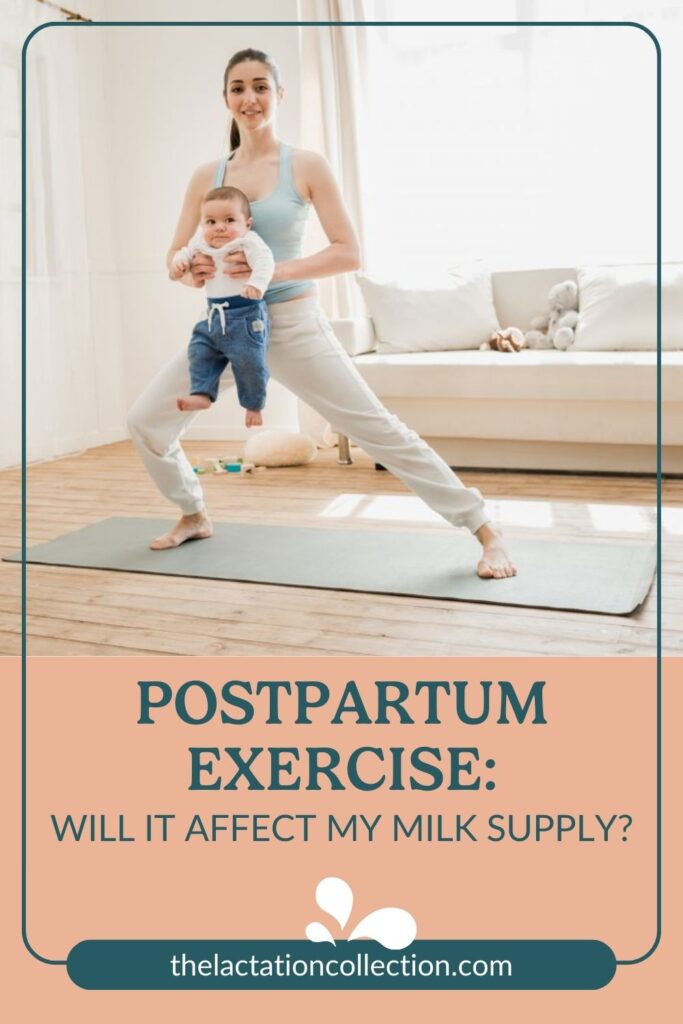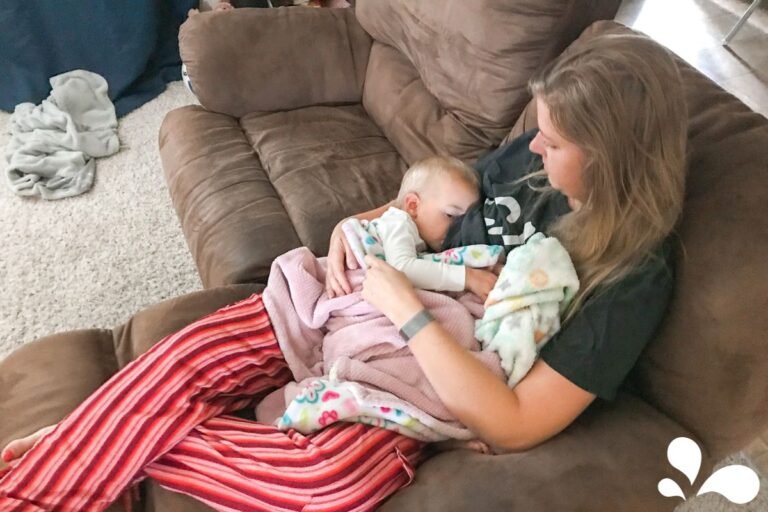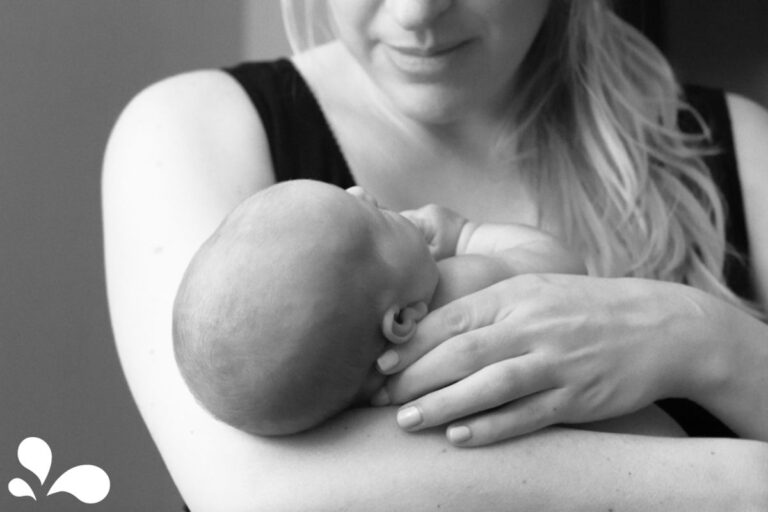Will exercise affect my breastmilk?
Exercise is an important part of having a healthy lifestyle and can/should be done in all stages of life. Whether you are pregnant and planning to breastfeed after delivery or you have already had your baby, you may wonder how exercise could affect your breastmilk.
If I exercise will my breastmilk supply decrease? The answer is NO.
Studies have shown exercise to have no negative effects on milk supply or content, maternal health, or infant growth (1, 2, 3). With moderate exercise and a healthy diet, your milk supply should not be affected.
Exercise can increase the level of lactic acid in breastmilk and may give a “sour” flavor to your milk for a short time after exercising. The sour flavor is not harmful to you or your baby, although it could cause your baby to refuse the breast after you’ve exercised (5). On the other hand, sometimes your baby will refuse the breast after you exercise because of the saltiness left from the sweat on your breast. Be sure to clean off your breasts before feeding your baby.
I haven’t had any problems with my milk supply or my baby refusing the breast for any reason after exercising.
One of the best ways to ensure a good milk supply is to feed your baby every 2-3 hours (or sooner if they show signs of hunger). So, if you do notice a slight drop in your milk supply, breastfeed more often and your milk supply will increase.
Blog post: Will I produce enough breastmilk for my baby?

Benefits of exercise while breastfeeding
I’ve noticed that when I exercise I have much more energy. I also feel more motivated to do more things during the day. Before I started exercising regularly, I had a hard time finding the motivation to do much of anything beyond taking care of myself and my daughter. I didn’t cook often, if at all. I waited until we ran out of clean clothes before finally doing laundry. And I had a hard time cleaning the house. After starting and continuing a regular exercise routine, I miraculously found the energy to do all of those things and then some (such as working on writing this article).
Here are a few more ways exercising after having a baby can help you(1, 2, 3, 4, 5, 6):
- Improve heart health
- Reduce weight
- Increase energy levels (I’m a believer)
- Reduce stress levels
- Improve sleep
- Give a more positive sense of well-being
- Help with the prevention/treatment of postpartum depression
Overall, I have more energy. I feel better. I sleep better…which I can prove with my Fitbit sleep tracking. I’ve lost weight (and am still losing weight). And, best of all, I am much more positive about my body and life.
How soon can I start exercising after delivery?
Within hours of delivery. No, that’s not a joke. You can do some pelvic floor exercises shortly after you deliver (4).
The American College of Obstetrics and Gynecology state that after a vaginal delivery, without any complications, some women are able to start increasing exercise within a few days of delivery.
After a C-section, with approval from your healthcare provider, you can start low-impact exercises about 2-6 weeks after delivery. Going on walks can be a great way to increase your physical activity and improve your physical and mental health.
Ultimately, when you start exercising after delivery is your choice. It all depends on how your body feels. It is recommended that you start with exercises that strengthen your core (abdominal and back muscles), then slowly increase the intensity of your workout.
It took me a couple months after having my baby to start exercising, and when I did start I wasn’t very consistent. That doesn’t matter, what matters is that I started and I have built up to being consistent (mostly because I noticed all the benefits listed above, it was worth it just to have more energy). I found it odd that I would have more energy after using energy to exercise, but it happened.
I had a gym membership, but found it difficult to find time to go to the gym and also find someone to take care of my daughter. I loved the classes that I was taking, but I hated dealing with all the details to make gym time happen. After a while, I stopped going. I decided that it wasn’t worth the stress.
Then I discovered Beachbody On Demand. I’m not an affiliate or rep for them but I completely endorse what they offer. I found that I could benefit from a huge variety of exercise classes that I could do at home. It was great. I could choose shorter or longer workouts depending on the amount of time I had, and I could do intense cardio, fun dancing, or do pilates or yoga. They also offer prenatal yoga and mommy-and-me yoga. It is very cost effective. So much cheaper than a gym membership! Beachbody On Demand has worked great for me. I do the workouts, but I don’t completely follow their nutrition guides.
Figure out what works best for you, whether that’s exercising at the gym or at home, taking walks or riding a bike, waking up early and exercising before anyone else wakes up or exercising during nap time. Do what works best for you.

Before you jump in, here are some recommendations before exercising
These tips will help make exercising while breastfeeding a little easier: (1, 4)
- Breastfeed (or pump) before you exercise
- Wear a supportive bra
- Drink plenty of water
- Maintain a healthy diet
I am currently breastfeeding my 13-month-old daughter and I still have a hard time with high-impact exercises that involve jumping up and down. They hurt my breasts. You might not have the same issue. If not, lucky you. I modify the exercises and still get a good workout without doing full jumping jacks or burpees (I prefer the modified version of burpees anyway, because let’s be real…who likes burpees?).
A little note about nutrition
Eating a healthy diet is important when exercising while breastfeeding. Breastfeeding alone burns an extra 300-500 calories a day, so make sure that you are eating enough food to make up for those calories as well as the calories you burn during exercise. Your recommended daily calorie intake is determined by your height, weight, and activity level as well as if you are trying to maintain your current weight or lose weight.
To calculate your daily calorie needs and to learn more about calories and weight loss click here. And remember to add 300-500 calories to the number that is calculated since you are breastfeeding.

I found that counting calories is the best way for me to watch what I eat. If I have to write it down (put it in my app – I use the Fitbit App – My Fitness Pal is also a good option), then I am more careful about what I eat and how much of it I eat. I don’t like to go on “diets” and limit my carb intake.
I happen to be a person who, when told that I can’t eat sugar and carbs, that is all I want. I can do it for a couple days, but then I binge and “eat all the things.” I think the best goal is to try to eat more fruits, veggies, and protein, and decrease the amount of carbs.
You don’t have to cut out the chocolate completely; I know I don’t always handle that very well. So again, find what works for you and follow that.
*Disclaimer: I am sharing what I have found in research articles and combining that research with my own personal experience. All women are different and some women’s bodies may react differently to an increase in activity than others. Exercise should be started and continued with approval from your healthcare provider.
I hope that these tips will help you as you move forward with your goal and that all the articles you read here help you feel more empowered and confident with the choices you are making.
You are powerful. I hope this article has helped you recognize the power that you already have within, and that you will join me in spreading that recognition to everyone you know.
Sources:
(1) American College of Obstetricians and Gynecologists (2015). Physical activity and exercise during pregnancy and the postpartum period. Committee Opinion Number 650. Retrieved on January 4, 2018 from, https://www.acog.org/Clinical-Guidance-and-Publications/Committee-Opinions/Committee-on-Obstetric-Practice/Physical-Activity-and-Exercise-During-Pregnancy-and-the-Postpartum-Period#60
(2) Artal, R. (2017). Exercise during pregnancy and the postpartum period. In V.A. Barss (Ed.), Uptodate. Retrieved on January, 17, 2018 from, https://www.uptodate.com/contents/exercise-during-pregnancy-and-the-postpartum-period
(3) Cary, G.B. & Quin, T.J. (2001). Exercise and lactation: Are they compatible? The Canadian Journal of Applied Physiology, 26(1), 55-75. https://doi.org/10.1139/h01-004
(4) Hammer, R. L., Perkins, J., & Parr, R. (2000). Exercise during the childbearing year. The Journal of Perinatal Education, 9(1), 1–14. http://doi.org/10.1624/105812400X87455
(5) Larson-Meyer, D. E. (2002). Effect of postpartum exercise on mothers and their offspring: A review of the literature. Obesity Research, 10(8), 841-853. doi:10.1038/oby.2002.114
(6) Rich, M., Currie, J., & McMahon, C. (2004). Physical exercise and the lactating woman: A qualitative pilot study of mothers’ perceptions and experiences. Breastfeeding Review, 12(2), 11-18. https://www.ncbi.nlm.nih.gov/pubmed/17891862








